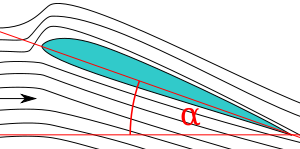 Image via Wikipedia
Image via Wikipedia
By Doug Daniel
When smooth airflow separates from your wings they stall, losing most of their lift. If you are lucky the airplane drops like a brick, pitches down, accelerates and starts to fly normally again. If you are not so lucky, one wing stalls, rolling your airplane toward the stalled wing as it progresses to a spin before you can recover. It is probably a good idea to keep the airflow attached to the wing and the tail and every other surface needed for controlled flight.
An aerodynamicist would tell you that stalls can only occur when an airfoil reaches or exceeds its critical angle of attack. I would say that a stall occurs only when you try to make the wind turn too sharp a corner.
You see, air is sticky. Not very sticky but it is a little sticky. An aerodynamicist would clear his throat; raise his eyebrows and say, "Viscous." So let's ignore the aerodynamicist. It's sticky. When air blows past a gently curved surface, like a wing, it tends to stick to the surface even though the surface curves away from the wind.
If the wing is symmetric top and bottom and the wind is coming straight on, the wind impacts the front of the wing and builds a high pressure area there. Then as it starts to follow the contour of the wing, like anything following a curved path, it gets pulled out. But its stickiness holds it next to the surface. The result is low pressure over most of the surface, top and bottom.
Now if you pitch the wing up a bit by pulling back on the stick a bit, the air on top must change direction a bit more than the air on the bottom. The result is more low pressure on the top and less on the bottom. Perhaps the high pressure area on the bottom of the wing is bigger than before. The wing is sucked up by the top and pushed up by the bottom. We call this lift.
Suppose you pitch the wing up a lot by pulling the stick a long way back. The air on the top has to change direction a lot and the pressure on the top drops a lot. If you pull the stick far enough, the low pressure area on the top of the wing sucks air from the back of the wing forward, separating the airflow from the top of the wing. This is bad. The low pressure area on the top of the wing disappears as it is filled by the forward flowing air. The wing loses lift. This is a stall.
The airflow separates from the wing of a properly designed airplane before it separates from the tail. If the tail has lift and the wing doesn't the airplane's wing drops and the tail doesn't. This is a good thing because the wing comes down and faces a lower pitch attitude. The results are that the wind re-attaches to the upper surface, lift is restored and the airplane returns to normal.
Now suppose the pilot continues pulling back on the stick. As soon as the wing develops lift, it goes up too far again and stalls again. We call this bobbing action 'buffeting.'
Buffeting is good because it warns the pilot that he or she is pulling too hard on the stick and the wing is ready to enter a serious stall - one that could lead to a potentially fatal spin.
So now we know that the real warning of an impending serious stall is buffeting. We also know that buffeting is caused by pulling the stick too far. So we know that the way to avoid a stall is to pull less when we feel buffeting. We also know that if we pull less on the elevator, that the airplane will go down. That could be a really bad thing. Increasing the engine's power simultaneously with easing up on the elevator can mitigate that sinking feeling
Notice that no where in this discussion of what causes stalls and what to do about them was the concept of airspeed needed. Stalls are only caused by pitching the wings up too far - nothing else. Even though stalling speed is a useful term, there really is no unique stalling speed for an airplane. You have to read the fine print. What 'stall speed' usually means is the speed at which an airplane's wing exceeds its maximum pitch attitude if the airplane is loaded to maximum landing weight, is in the landing configuration and flying straight ahead
Doug Daniel is a long time pilot, flight instructor, software engineering manager and author. His department developed the software for the out-the-window-displays for the space shuttle, F-117, RS-71 and numerous other exotic aircraft simulators. His writing focuses on flying techniques designed to make flying easier and safer. If this was interesting, visit his website at http://www.FlyingSecretsRevealed.com/flying_questions/
Article Source: http://EzineArticles.com/?expert=Doug_Daniel
http://EzineArticles.com/?Airplanes-Dont-Stall,-Pilots-Stall-Them&id=2010448




